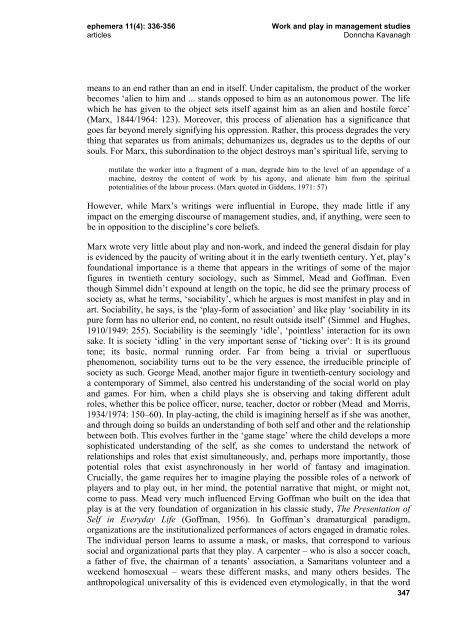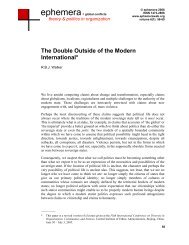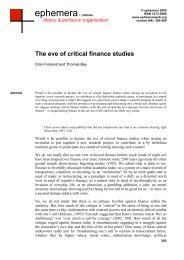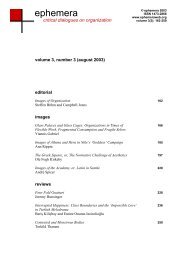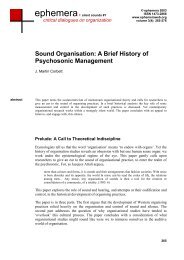Work, play and boredom - Ephemera
Work, play and boredom - Ephemera
Work, play and boredom - Ephemera
Create successful ePaper yourself
Turn your PDF publications into a flip-book with our unique Google optimized e-Paper software.
ephemera 11(4): 336-356 <strong>Work</strong> <strong>and</strong> <strong>play</strong> in management studies<br />
articles Donncha Kavanagh<br />
means to an end rather than an end in itself. Under capitalism, the product of the worker<br />
becomes ‘alien to him <strong>and</strong> ... st<strong>and</strong>s opposed to him as an autonomous power. The life<br />
which he has given to the object sets itself against him as an alien <strong>and</strong> hostile force’<br />
(Marx, 1844/1964: 123). Moreover, this process of alienation has a significance that<br />
goes far beyond merely signifying his oppression. Rather, this process degrades the very<br />
thing that separates us from animals; dehumanizes us, degrades us to the depths of our<br />
souls. For Marx, this subordination to the object destroys man’s spiritual life, serving to<br />
mutilate the worker into a fragment of a man, degrade him to the level of an appendage of a<br />
machine, destroy the content of work by his agony, <strong>and</strong> alienate him from the spiritual<br />
potentialities of the labour process. (Marx quoted in Giddens, 1971: 57)<br />
However, while Marx’s writings were influential in Europe, they made little if any<br />
impact on the emerging discourse of management studies, <strong>and</strong>, if anything, were seen to<br />
be in opposition to the discipline’s core beliefs.<br />
Marx wrote very little about <strong>play</strong> <strong>and</strong> non-work, <strong>and</strong> indeed the general disdain for <strong>play</strong><br />
is evidenced by the paucity of writing about it in the early twentieth century. Yet, <strong>play</strong>’s<br />
foundational importance is a theme that appears in the writings of some of the major<br />
figures in twentieth century sociology, such as Simmel, Mead <strong>and</strong> Goffman. Even<br />
though Simmel didn’t expound at length on the topic, he did see the primary process of<br />
society as, what he terms, ‘sociability’, which he argues is most manifest in <strong>play</strong> <strong>and</strong> in<br />
art. Sociability, he says, is the ‘<strong>play</strong>-form of association’ <strong>and</strong> like <strong>play</strong> ‘sociability in its<br />
pure form has no ulterior end, no content, no result outside itself’ (Simmel <strong>and</strong> Hughes,<br />
1910/1949: 255). Sociability is the seemingly ‘idle’, ‘pointless’ interaction for its own<br />
sake. It is society ‘idling’ in the very important sense of ‘ticking over’: It is its ground<br />
tone; its basic, normal running order. Far from being a trivial or superfluous<br />
phenomenon, sociability turns out to be the very essence, the irreducible principle of<br />
society as such. George Mead, another major figure in twentieth-century sociology <strong>and</strong><br />
a contemporary of Simmel, also centred his underst<strong>and</strong>ing of the social world on <strong>play</strong><br />
<strong>and</strong> games. For him, when a child <strong>play</strong>s she is observing <strong>and</strong> taking different adult<br />
roles, whether this be police officer, nurse, teacher, doctor or robber (Mead <strong>and</strong> Morris,<br />
1934/1974: 150–60). In <strong>play</strong>-acting, the child is imagining herself as if she was another,<br />
<strong>and</strong> through doing so builds an underst<strong>and</strong>ing of both self <strong>and</strong> other <strong>and</strong> the relationship<br />
between both. This evolves further in the ‘game stage’ where the child develops a more<br />
sophisticated underst<strong>and</strong>ing of the self, as she comes to underst<strong>and</strong> the network of<br />
relationships <strong>and</strong> roles that exist simultaneously, <strong>and</strong>, perhaps more importantly, those<br />
potential roles that exist asynchronously in her world of fantasy <strong>and</strong> imagination.<br />
Crucially, the game requires her to imagine <strong>play</strong>ing the possible roles of a network of<br />
<strong>play</strong>ers <strong>and</strong> to <strong>play</strong> out, in her mind, the potential narrative that might, or might not,<br />
come to pass. Mead very much influenced Erving Goffman who built on the idea that<br />
<strong>play</strong> is at the very foundation of organization in his classic study, The Presentation of<br />
Self in Everyday Life (Goffman, 1956). In Goffman’s dramaturgical paradigm,<br />
organizations are the institutionalized performances of actors engaged in dramatic roles.<br />
The individual person learns to assume a mask, or masks, that correspond to various<br />
social <strong>and</strong> organizational parts that they <strong>play</strong>. A carpenter – who is also a soccer coach,<br />
a father of five, the chairman of a tenants’ association, a Samaritans volunteer <strong>and</strong> a<br />
weekend homosexual – wears these different masks, <strong>and</strong> many others besides. The<br />
anthropological universality of this is evidenced even etymologically, in that the word<br />
347


